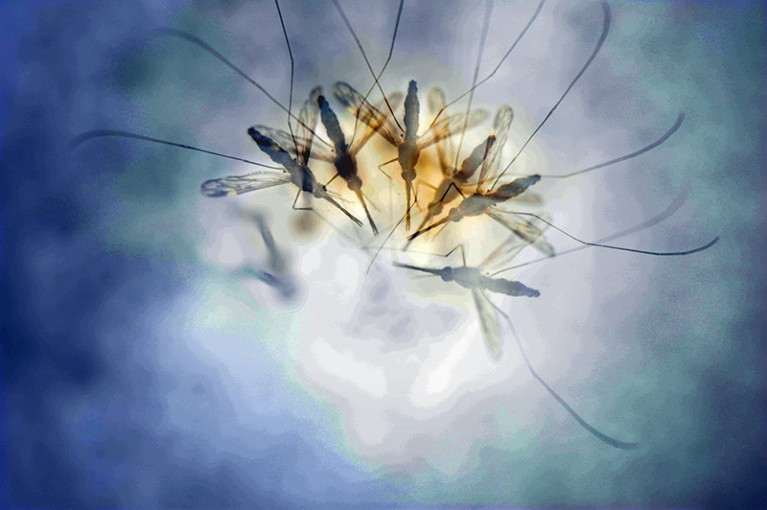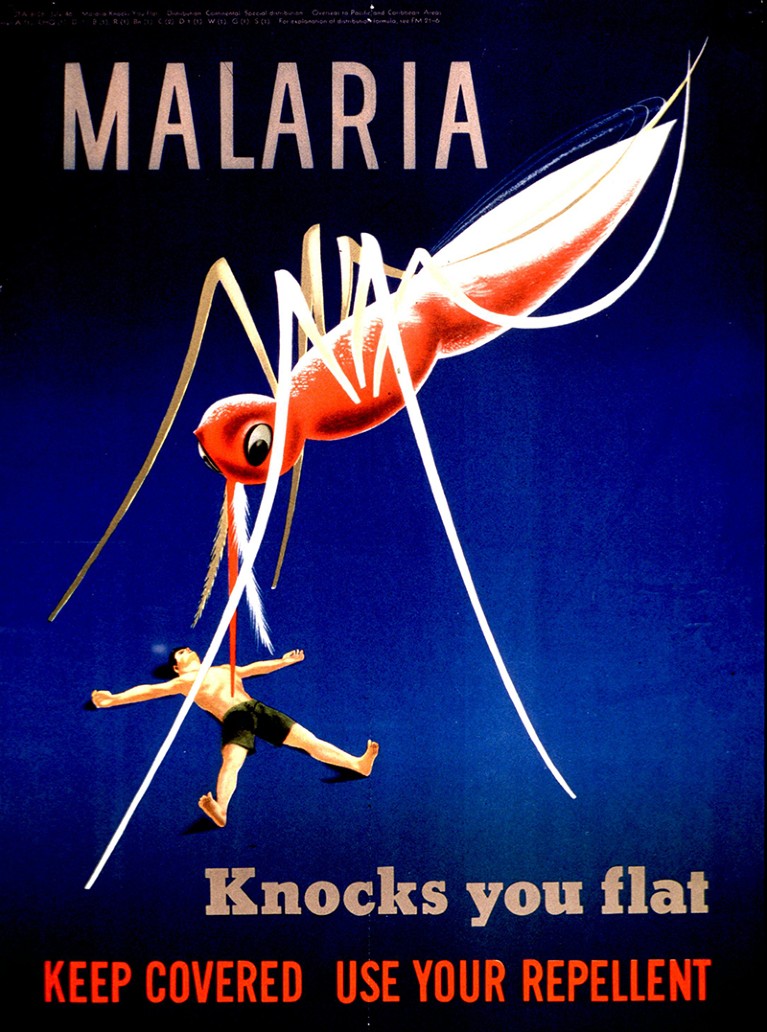
A multiple-exposure image of a single Anopheles punctipennis mosquito, on display at the Smithsonian Natural History Museum in Washington DC.Credit: Sarah L. Voisin/Washington Post/Getty
The Mosquito: A Human History of Our Deadliest Predator Timothy C. Wineguard Dutton (2019)
The deadliest beast on Earth is the featherweight mosquito. Among the diseases it passes on — such as filariasis, yellow fever, dengue, Zika and West Nile fever — malaria accounted for 435,000 deaths in 2017. Inevitably, the insect has inspired many books. So what does the baldly titled tome The Mosquito add to the canon? The answer: a lot.
Military historian Timothy Winegard’s book takes readers on a riveting adventure, documenting the mosquito’s outsized role in conflict since antiquity. He shows how, from vast empires to contemporary war zones, the advantage fell to any defending army able to stall attackers in mosquito-filled swamps, where fevers — mostly malaria, yellow fever and dengue — sapped their strength. Through this lens, he explains in superb detail how great powers rose and fell.
We learn how, in fifth-century bc Greece, Persian troops crumbled when a coalition of Athenians and Spartans forced them into marshlands before the Battle of Plataea. A mix of malaria (transmitted by the Anopheles mosquito) and dysentery felled 40% of the Persian ranks. Thus “General Anopheles”, writes Winegard, freed Greeks from Persian rule, and enabled the blossoming of Greek philosophy, science and art — the ‘Golden Age’ that in part paved the way for Western civilization.
Winegard relates, too, the mosquito’s role in the fall of Rome. For hundreds of years up to the fifth century ad, the malarial Pontine Marshes around Rome staved off attacks by Carthaginians, Germanic tribes and Huns, yet weakened Roman citizens. Over the following 300 years, malaria also helped to ground the Holy Roman Empire. Christian hospitals took in the masses of infected people, proselytizing a doctrine of care that won over pagans and ultimately paved the way for Charlemagne’s claim on Europe. The thread of influence runs all the way to the Vietnam War, when mosquito-borne diseases made US occupation of the North Vietnamese-held jungles untenable.

A US poster from a 1920 campaign urging people to protect themselves against malaria.Credit: Smith Collection/Gado/Getty
Although Winegard’s approach is at times too broad and unscientific, it is fascinating. And he covers some research well, such as why mosquitoes bite humans selectively. (The science is still uncertain, but evidence suggests that 20% of people receive 80% of bites: T. A. Perkins et al. PLoS Comput. Biol. 9, e1003327; 2013.) Ultimately, however, Winegard is strongest on the world-changing aspects of malaria — not only the rise and fall of empires, but also areas such as the nexus of genetics, society and politics.
He discusses, for instance, a link between the Atlantic slave trade and genetic resistance to the malaria pathogen Plasmodium vivax. The Duffy antigen on red blood cells is the receptor for P. vivax, thus helping to launch infection. Anyone lacking this antigen is resistant to malaria, and that includes 95% of people of West African descent. Most of the people wrenched into slavery in the Americas came from this region; and, in a horrible irony, their resistance to the disease — observed by plantation owners — created demand for their work and became a driver of the slave trade.
Winegard overflows with enthusiasm for his subject. At times, however, his hammering at perspectives that he wants us to take away comes at the expense of nuance and specificity. A case in point is his narrative on a horrific chapter of the Second World War, when human experiments to find an antimalarial were carried out by both Nazi Germany and the United States.
Winegard cites my work (The Malaria Project, 2014), which details how the German malariologist Claus Schilling deliberately infected some 1,000 prisoners in the Dachau concentration camp. Winegard claims that 400 of them perished as a result. My research showed that 38 died in Schilling’s hospital wing, from the effects of two particularly toxic drugs. Typhus and dysentery might well have killed others, once they were released back to the barracks.
Meanwhile, Winegard downplays the fact that more than 100 US doctors were simultaneously doing the same thing, on a vastly greater scale. They experimented on 10,000 enlisted military personnel and inmates at six state hospitals and three prisons — including the notorious Stateville Penitentiary outside Chicago, Illinois. The death toll is estimated to have been between 10% and 30%. By not including this shocking episode of US medical history, Winegard misses a valuable application of his own framework: that one insect had driven so many doctors into inhumane, medically desperate work.
Winegard also lacks nuance in asserting that new technologies will soon extinguish the mosquito. Some of the science is indeed promising. Research published this month in Nature, for instance, shows how irradiation and bacterial infection were used to nearly eradicate tiger mosquitoes (Aedes albopictus) from two river islands in China (X. Zheng et al. Nature 572, 56–61; 2019). Mosquito specialist Peter Armbruster has questioned the scalability and sustainability of this work, however (P. A. Armbruster Nature 572, 39–40; 2019) . Even trickier is the use of CRISPR and gene drives, in which laboratory-raised mosquitoes pass on an altered gene to generations of wild mosquitoes — work that is still theoretical.
Finally, there is the issue of Winegard’s view of the insect. He sees it solely in human terms, setting it up as a foe to humanity, with no other role in nature. To claim that some 3,000 species of mosquito exist for no reason other than to act as our “apex predator” is bold, but it rests on unsound scientific footing.
His larger points in The Mosquito remain valuable, built on the solid work of scholars and scientists. Ever since Homo sapiens moved away from hunting and gathering, we have paid dearly for tangling with nature. As we tear down forests, cultivate fields and transform our environment, we create perfect habitats for mosquito propagation. And — more to Winegard’s point — as we shred the Earth with weaponry and park large armies in marshlands, we create ideal conditions for mosquitoes to spread disease. Humans, he rightly notes, help mosquito species to diversify, adapt and thrive as we reshape the planet.
When mosquitoes turn to us for blood, they transfer all the microbes they’ve evolved to carry. We have had no choice but to fight back. So, in this sense, we are at war with mosquitoes, from the multi-billion-dollar global health campaigns against mosquito-borne diseases — funded largely by wealthy countries through international agreements, and donors such as the Bill & Melinda Gates Foundation — to the pesticides that many spray in their backyards. Mosquitoes control our behaviour because we have yet to control them. Winegard’s earnest voice on this brings the seriousness of research and action on the mosquito up to the needed decibel.



 There’s a jungle in your bed
There’s a jungle in your bed
 A life of insects and ire
A life of insects and ire
 Journal of the plague years
Journal of the plague years
 The malaria wars
The malaria wars








